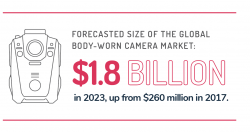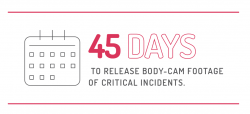White Paper
AI Body Cam Redaction software becomes Essential for California Police Amid New Body-Cam Legislation
The passage of California Assembly Bill 748 (AB-748)[i] has clamped California’s law-enforcement agencies in a vise, squeezing them between conflicting mandates for rapid transparency and privacy protection.

Simply put, AB-748 requires police to release audio & video captured during critical incidents within just 45 days of a request bypublic or other organizations. However, before such video footage is released, it must be redacted, removing any content that might divulge the identity of innocent people.
Manual redaction processes require extensive manpower and expertise to review each frame and make edits, such as obscuring the faces of witnesses. These procedures are also time-consuming, taking 10 minutes or more to redact just one minute of video.[ii] As a result, many law-enforcement agencies simply lack the resources to manually redact and release large quantities of video within the time constraint mandated by AB-748.
Luckily, a solution to California police’s dilemma has arrived: artificial intelligence (AI) technology that can automate redaction of video and image-based evidence. Using AI, agencies can streamline and accelerate the video and audio review and redaction process, allowing for release of large quantities of content within 45 days of a request.
 With the possibility that AB-748 could influence legislation elsewhere, AI-based redaction could find widespread acceptance in the fast-growing body-cam market. The global body-worn camera business is expected to expand at a compounding annual growth rate (CAGR) of 38.2% over the next five years, reaching $1.8 billion in 2023, up from $260 million in 2017.[iii]
With the possibility that AB-748 could influence legislation elsewhere, AI-based redaction could find widespread acceptance in the fast-growing body-cam market. The global body-worn camera business is expected to expand at a compounding annual growth rate (CAGR) of 38.2% over the next five years, reaching $1.8 billion in 2023, up from $260 million in 2017.[iii]
Bill Burdens California Police
Passed in September 2018, AB-748 resolved a protracted debate that pitted issues of transparency, privacy and police conduct against each other. The legislation was sponsored by the American Civil Liberties Union (ACLU) and the California Newspaper Publishers Association (CNPA) to address perceived police secrecy and to promote government openness and accountability.

The bill specifically states that starting on July 1, 2019, audio and video relating to a critical event, such as a use-of-force incident, must be released within the 45-day time limit of a public request. AB-748 includes specific language related to the redaction of content that could violate individuals’ privacy:
The bill would allow the recording to be withheld if the public interest in withholding video or audio recording clearly outweighs the public interest in disclosure because the release of the recording would, based on the facts and circumstances depicted in the recording, violate the reasonable expectation of privacy of a subject depicted in the recording, in which case the bill would allow the recording to be redacted to protect that interest.
The bill also states that agencies may use redaction technology to obscure portions of a recording in order to protect an individual’s privacy.
Police unions and associations opposed the bill, citing the encumbrances it places on departments.
Aside from the impact on investigations/prosecutions, this bill imposes an enormous financial burden on departments,” said the Association for Los Angeles Deputy Sheriffs (ALADS) in an official statement. “The vague definition of what is ‘reasonably believed’ to involve a policy or law violation requires the storage and cataloging of an unlimited amount of footage, as the value or relevance of footage may not be immediately known. This state law provides no reimbursement but leaves departments open to charges they are avoiding releasing footage when in fact they may not be able to access the footage immediately.[iv]
Body Cam and Video Footage in Policing
The burdens cited by ALADS are expected to grow heavier as usage of body-cams and video footage becomes increasingly common in law enforcement.
Already, more than 80 percent of all criminal cases involve video evidence.[v] A total of 3.3 trillion hours of video surveillance footage will be captured every day in 2019.[vi] More than half of all medium-to-large police departments in the U.S. now are using or testing body-worn surveillance cameras.[vii]
While body cams and video surveillance ostensibly should improve law enforcement processes, they often generate new costs and inefficiencies. When a police department adds a redaction workflow to its operations, the additional work can divert staff members from their core responsibilities. It also can require agencies to hire new staff or contract out the redaction process, incurring significant expenses.
For example, the city of Baltimore estimated that redaction-related costs could amount to as much as 21 percent of its budget for its police body-cam program—totaling $1.7 million in the first year alone.[viii]
For many agencies, these new expenditures are simply unaffordable.
AI Tackles Redaction
AI technologies now on the market offer a way for agencies to meet the strict time constraints of AB-748 without busting their budgets. A large variety of technology providers now are offering increasingly accurate algorithms that can identify heads, license plates and other personally identifiable information (PII) contained within video and audio footage. Reviewers can use this information to locate and redact all PII that raises privacy concerns.
When used in a redaction solution, these algorithms can place potential PII into lists that can be previewed by users. Users then could quickly define which PII needs to be redacted and the solution would automatically obscure PII from each frame of video.
Users would then define additional sensitive items appearing in the video evidence, such as license plates, and choose to automatically track the defined item for redaction throughout the video or at a single timestamp. Once all automatically detected heads are reviewed and additional targets defined for obfuscation by the user, the video could be easily redacted with one click.
This dramatically cuts down on redaction times compared to manual review and editing workflows, taking minutes to perform tasks that previously consumed countless hours. Such a system also could be utilized effectively by users at all levels of expertise, not requiring extensive training in video redaction.
Taking Action on Body Cam Redaction
Veritone RedactTM provides just such a solution. Packaged as a complete solution, Veritone Redact empowers law enforcement agencies to manage their digital evidence redaction software workflow in one place with the capability to tag the status of evidence redactions, as well as to export fully redacted audio and video files, including audit logs detailing edits made to evidence by individual users to support chain of custody requirements.
Veritone Redact is an equipment-agnostic solution, enabling users to simply upload video or audio evidence from a local computer or cloud repository. Once uploaded, users open redaction projects for specific evidence files to run automatic head/PII detection.
As California’s police agencies find themselves increasingly crushed between the conflicting demands of protecting privacy and complying with AB-748, they are likely to embrace AI-based body camera redaction technologies and solutions. And with California’s legislation possibly influencing laws in other states in the future, agencies everywhere need to look at the examples set by California’s law-enforcement as they adopt and integrate AI redaction solutions.
Learn how Veritone can help you redact heads and objects from video evidence used in investigations, surveillance and criminal justice here.Citations:
[i]leginfo.legislature.ca.gov/faces
[ii]azure.microsoft.com- using-ai-to-automatically-redact-faces-in-videos
[iii]growth-in-police-body-worn-cameras-fuels-digital-evidence-management-market-evolution
[iv] https://www.evidencemagazine.com
[v] www.unicomengineering.com - video-surveillance-and-the-rising-need-forstorage/
[vi] nytimes.com - police-body-cameras
[vii]mayor.baltimorecity.gov - Body Camera Working Group Recommendations
[viii]nist.gov - ist-evaluation-shows-advance-face-recognition-softwares-capabilities
[ix] https://www.veritone.com/applications/redact/